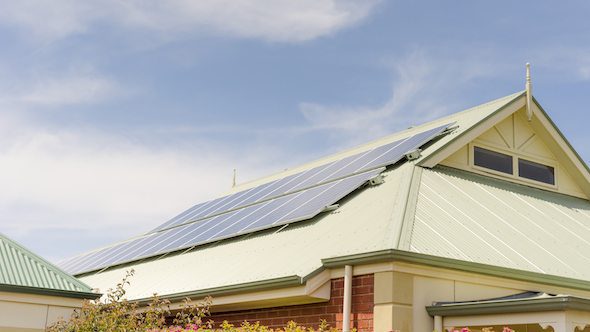The price of rooftop solar and battery storage for household and business consumers will fall to just 15c/kWh within a few years, leading to a dramatic reshaping of the energy grid, according to a leading network operator.

Rob Stobbe, the head of SA Power Networks, which operates the local network in South Australia, says rooftop solar has already fallen to around 5c/kWh for households and businesses.
The cost of battery storage, he says, will fall to within 10c/kWh of usable power within the next 5-10 years, meaning a total of 15c/kWh for solar and storage – less than half the cost of grid power in South Australia (35c/kWh).
“Why wouldn’t that new technology come on board,” he said, in a panel session at the presentation of the AEMO final report on last year’s “system black” in South Australia.
The dramatic forecasts by one of the country’s key network owners highlights just how fast, and how extensive, the national grid’s shift from centralised to distributed energy will be.
And it has huge implications, not just for the way the network businesses are run, but also for the generators and retailers – often the same company – that operate most of the centralised generators and bill the customers.
Stobbe says that in South Australia, he expects at least 70 per cent of all its 850,000 customers to have rooftop solar, and 50 per cent of its customers to have battery storage by 2035.
In a grid that has a peak load of just over 3,000MW, and average load of around 1,500MW, rooftop solar will have combined capacity of some 2,000MW, with another 2,000MW of battery storage on top of that.
Then, he says, there will another 2,000MW or so of vehicle battery storage – with 30 per cent of customers taking up EVs – both drawing down from the grid at certain times, but also able to provide much of that capacity at others.
“Solar from the roof itself will have a big impact. No doubt within 5-10 years, those prices will come down significantly.
“There is no doubt the industry is changing significantly. We have to got to change too.” He said it was already becoming a two-way network to enable all this distributed generation to be linked.”
“These are the most exiting and challenging times that the industry is facing. We are moving from a one size fits all type arrangment where we have centralised generation running through transmission lines through our network and to the customer.
“We are really moving to a lot more diverse generation, large and small scale generation … really, that is the future.”
Indeed, the CSIRO and the networks lobby have predicted that more than half of all electricity supply will come from rooftop solar and other distributed generation, and in South Australia, which already sources half of its demand from wind and solar, will likely move to around 85 per cent renewable energy by 2035.
The forecasts from SAPN support this. Currently, the state has around 650MW of rooftop solar, and some 1,600MW of wind energy.
But with rooftop solar set to treble, more wind farms plans, and a host of various large scale solar farms to be built, some with storage, this is likely to dramatically change the face of the state’s generation profile.
So much so, Stobbe has said in the past, that he cannot see a future of large scale generators and retailers of the type that exist now.
Indeed, he accused the so-called “gentailers” of being the cause of much of the recent doubling in electricity prices.
He particularly mentioned the bidding patterns, an issue raised by SAPN’s owners Spark Infrastructure in its Finkel submission, when it accused the generators of artificially forcing up prices by withdrawing capacity.
But he also noted that the high cost of wholesale electricity was the result of high gas prices. Because gas generation was the last bid into the market, that set the price, and it didn’t matter how much wind and coal generation there was.
“It not a capacity issue. We have got more installed generation than we need. But we may need to have a certain level of availability and the way it is bid into the market,” Stobbe said.
And he questioned what the rules were about the mothballing of plant which are “obviously useful” and the timing of maintenance.










